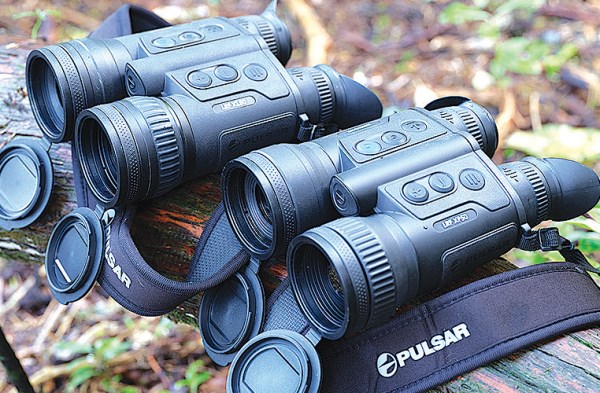
The Pulsar Merger LRF thermal bi-ocular range was launched in January 2022 with the Merger LRF XP50, replacing the highly successful Pulsar Accolade LRF XP50 Pro. The Merger LRF looks and feels like a compact binocular and incorporates useful new features. It became an instant success with discerning hunters and professionals alike, including Coastguard New Zealand, New Zealand Police and the Department of Conservation.
Call me pedantic, but the Merger LRF is actually a bi-ocular, meaning it has a single input channel and two eyepieces, unlike a binocular which has two input channels ie two objective lenses each carrying a separate image. Pulsar describe the Merger as a binocular which makes life a lot easier because it is a word that people are familiar with. On the other hand, the word bi-ocular looks like a misspelling, sounds like a speech impediment and causes non-stop running battles with spellcheckers!
Pulsar Merger LRF generic features
Pulsar products are manufactured in Lithuania, Latvia and the UK. All Merger LRF models are identical except for the sensor size and in respect of the Merger LRF XQ35, the objective lens. The lefthand tube incorporates the f1.0 precision germanium lens and sensor, whilst the right-hand tube houses a high performance singlechannel laser rangefinder. All Merger’s feature high performance Lynred sensors and HD AMOLED displays.
The Merger’s compact magnesium alloy body feels solid, is fully waterproof and dissipates internal heat for excellent image quality and electronic longevity. It is very comfortable to hold, easy to use and the eyepieces are adjustable for width and ocular focus. A Proximity Sensor puts the Merger into power-save mode when removed from the eyes and instantly turns back on when viewing; this is a very nice feature which can be disabled for tripod use. The Merger uses a convenient quick-change battery and has an internal back-up battery for 10 hours operation time.
The Merger’s laser rangefinder has single reading, scan and True Horizontal Distance modes. I found the rangefinder very fast and accurate, measuring a bush at 981m. Mergers have video recording / streaming and multiple colour palettes. I found that white-hot is the best for spotting animals easily, black-hot provides the best detail and sepia is best for reducing ‘night-blindness’.
Pulsar Merger LRF XP50
The Merger LRF XP50 is very well priced for a professional European made thermal bi-ocular. The 50mm f1.0 objective lens and 640×480 / 17µm Lynred thermal sensor forms a highly detailed image with a wide field-of-view and great zooming magnification.
Thermal sensitivity at NETD <25mK delivers exceptional fog, rain and foliage penetration, which is ideal for search and rescue, maritime use and spotting animals in rough terrains and conditions. In my opinion, the Merger LRF XP50 is the best allrounder.
Pulsar Merger LRF XL50
Launched this year, the Merger LRF XL50 is fitted with a Lynred HD 1024×768 / 12µm <40mK sensor that produces fantastic image detail and the widest field-of-view. It is ideal for precise identification and long-distance detection; zooming the magnification to 10x produces very good image detail, while 20x is still good, but a little wobbly when holding (could just be me), so using something to rest against is recommended.
The sensitivity of the Merger LRF XL50 is lower than the Merger LRF XP50 because its 12µm pixels have a smaller surface area than XP50’s 17µm pixels, though the NETD <40mK is still best available for 12µm sensors. Don’t be misled by manufacturers that claim that their 12µm sensors are NETD <25mK, I’ve compared these and it simply isn’t true.
Pulsar Merger LRF XQ35
With great anticipation, the Merger LRF XQ35 is due for serial production this October. The Merger LRF XQ35 has a Lynred 384×288 / 17µm NETD <25mK sensor and a 35mm f1.0 objective lens. The sensorand optics are the same as the outstanding Pulsar Axion LRF XQ35 Pro, which I’m a huge fan of.
The Merger LRF XQ35 offers all the advantages of its high-end stablemates, but at a lower cost. It has a good field-of-view, is more suitable when the need to zoom to a high magnification is less important and has the same high sensitivity as the Merger XP50. Look out for my review of this model in The Fishing paper &Hunting News.













